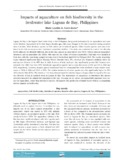Impacts of aquaculture on fish biodiversity in the freshwater lake Laguna de Bay, Philippines

Lihat/
Tarikh
2016Pengarang
Page views
607Metadata
Lihat penerbitan penuhCited times in Scopus
Share
abstrak
Laguna de Bay is the largest inland water body in the Philippines, being used predominantly for aquaculture and open water fisheries. Aquaculture in the lake began decades ago, with many changes in the lake ecosystem having occurred since that time. Most dominant species for fish culture are introduced species. Other invasive species were also introduced to the lake as escapees from land-based aquaculture facilities. This study was conducted to monitor fish diversity in two adjacent, but distinctly different, sites in the lake, namely an open fishery area (OFS), with no adjacent aquaculture structures, and an aquaculture site (AQS), with cages for the culture of various commodities. Fish traps were installed at both sites, with the traps being sampled at least every 2 weeks from April 2013 to February 2015. The results of pairwise t-tests indicated significantly higher Shannon–Wiener diversity index (H′), evenness (J′), Simpson's similarity index (D) and species richness (s) in OFS than in AQS. In terms of total catch per day, significantly greater fish biomass were obtained from AQS than from OFS. Introduced aquaculture species had a mean dominance of 83% and 47% in AQS and OFS, respectively. However, invasive species introduced from the ornamental fish trade exhibited a mean relative dominance of 10.3% in AQS and 13.5% in OFS. The relative dominance of native species was also significantly higher in OFS (41%) than in AQS (6.5%). The results of this study demonstrated the adverse impacts of aquaculture in regard to the species diversity of fish in localized areas in Laguna de Bay. The dependency of aquaculture on introduced fish species adversely impacted the natural fish population in the lake. Focusing on the culture of commercially important local species for aquaculture, rather than introduced species, will improve fish production of inland waters without accompanying adverse impacts on biodiversity.
Suggested Citation
Cuvin-Aralar, M. L. A. (2016). Impacts of aquaculture on fish biodiversity in the freshwater lake Laguna de Bay, Philippines. Lakes and Reservoirs: Research & Management , 21(1), 31-39. https://doi.org/10.1111/lre.12118
Subjek
Koleksi
- AQD Journal Articles [1249]
